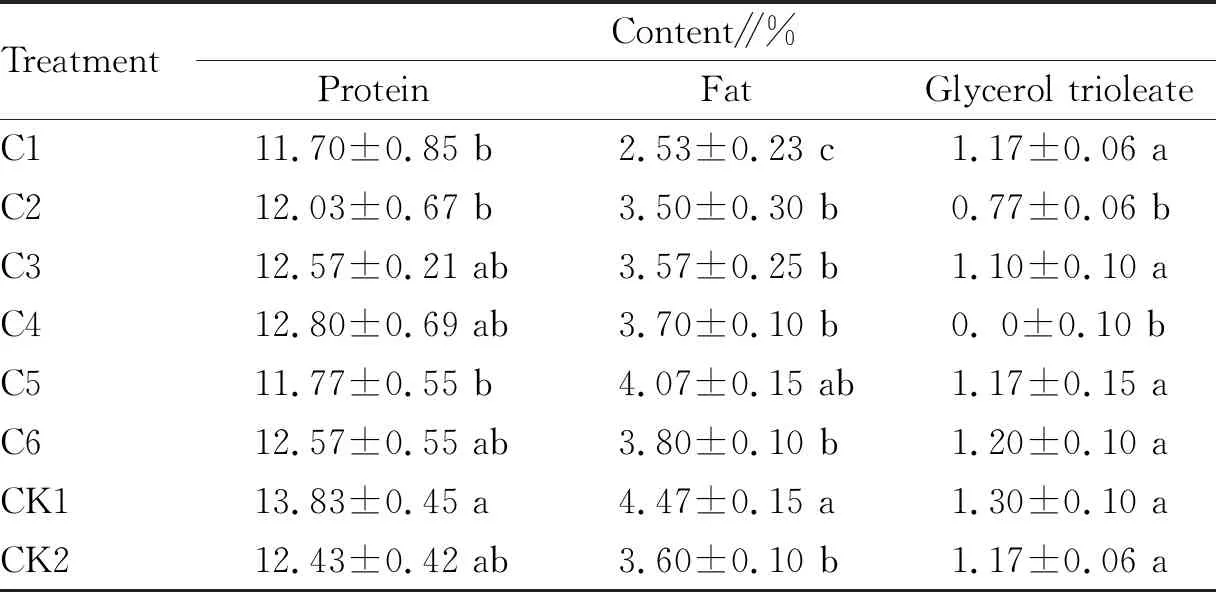Effects of Different Herbicides on Weed Control, Agronomic Characters and Grain Quality of Coix lacryma-jobi L.
Maohong AO, Zhiqin SONG, Xiaoyu YANG
1. Institute of Subtropical Crops, Guizhou Academy of Agricultural Sciences, Xingyi 562400, China; 2. Institute of Crop Variety Resources, Guizhou Academy of Agricultural Sciences, Guiyang 550000, China
Abstract [Objectives] The paper was to study the effects of different herbicides on weed control, agronomic characters and grain quality of Coix lacryma-jobi L. [Methods] Six commonly used herbicides were selected for the trial, including atrazine SC, butachlor SC, monosulfuron WP, MCPA-starane EC, clopyralid AS and tribenuron-methyl WP. [Results] (i) Atrazine, butachlor and monosulfuron had no chemical injury to C. lacryma-jobi L., while clopyralid caused slight chemical injury. (ii) The fresh weight control effects of atrazine, butachlor and monosulfuron on weeds increased first and then decreased. The initial control effect of MCPA-starane and clopyralid reached more than 90%; the control effect of monosulfuron increased gradually in the late stage, reaching 97% at 60 d post spraying, and the overall control effect was optimal. (iii) Compared with manual weeding, herbicides had no significant effect on plant height of C. lacryma-jobi L. However, compared with no weeding, other herbicides except tribenuron-methyl inhibited plant growth to a certain extent. Herbicides had different effects on main stem diameter, tiller number per plant and grain number per plant of C. lacryma-jobi L. (iv) Different herbicides had no significant effect on 100-grain weight, but had significant effect on yield. (v) Compared with manual weeding, atrazine, butachlor and clopyralid decreased the protein content of C. lacryma-jobi L., and the use of atrazine, butachlor, monosulfuron, MCPA-starane and tribenuron-methyl decreased the fat content of C. lacryma-jobi L.; butachlor and MCPA-starane decreased the glycerol trioleate content of C. lacryma-jobi L. Compared with no weeding, chemical herbicides had no significant effect on the protein content, while atrazine decreased the fat content, and butachlor and MCPA-starane decreased the glycerol trioleate content of C. lacryma-jobi L. [Conclusions] The use of herbicides significantly increases crop yield compared with no weeding, but has an impact on agronomic characters and grain quality.
Key words Herbicide; Coix lacryma-jobi L.; Weed control; Agronomic character; Grain quality
1 Introduction
Coixlacryma-jobiL. is an annual or perennial herb plant belonging toCoix, Gramineae. It is one of the important medicinal and edible crops in China, and its grain has important medicinal and edible value[1]. Guizhou is a genuine producing area ofC.lacryma-jobiL. and a core planting area ofC.lacryma-jobiL. in China. The annual planting area ofC.lacryma-jobiL. is about 53 000 hm2, occupying more than 80% of the national planting area. Xingren City of Southwest Guizhou Autonomous Prefecture was awarded the title of "the hometown of myotonin" by China Grain Industry Association, andC.lacryma-jobiL. has become a local characteristic side crops industry[2]. Guizhou is a typical karst mountainous area with fragmented arable land.C.lacryma-jobiL. is mainly planted in dry and barren sloping land, and in the rainy season afterC.lacryma-jobiL. sowing, weeds grow wildly in the field. Due to the lack of rural labor force and the increase of labor cost, manual weeding is impractical in the field ofC.lacryma-jobiL.[3]. The application of chemical herbicides not only effectively reduces the cost of weed control and improves labor efficiency, but also increases crop yield due to its weed control effect, which is widely used by farmers[4]. The control effect of herbicides on weeds is mainly attributed to time difference, morphology, physiological and biochemical selectivity. However, according to the research on other crops, agricultural crops do not have absolute tolerance and resistance to herbicides. Excessive, long-term and improper use of herbicides will cause physiological damage to crops, resulting in chemical injury and even total crop failure, causing losses to production[5-9].C.lacryma-jobiL. is a gramineous crop, and the main field weeds in the production are gramineous weeds and broadleaf weeds[10]. When the rain comes, the weeds grow in synchrony withC.lacryma-jobiL., and compete for limited nutrients and living space, thus severely inhibiting the growth and development ofC.lacryma-jobiL. If weeds are allowed to grow wildly without any weeding intervention, they will basically cause the extinction of production. The weed has become a factor limiting the industrial development ofC.lacryma-jobiL.
C.lacryma-jobiL. belongs to the category of minor grain crops in the field of grain, and the scientific research onC.lacryma-jobiL. started late compared with other main grain crops[11]. Through literature review, the published literature reports related toC.lacryma-jobiL. mainly focused on the aspects of high-yield cultivation, variety selection, plant physiology, medicinal value and clinical prescription application, while no relevant literature reports were found on the control effect of herbicide on weeds in the field and the correlation effect on agronomic characteres and quality ofC.lacryma-jobiL.[12-13]. At present, there is no specialized herbicide forC.lacryma-jobiL. in the market, and the farmers mainly purchase the herbicides commonly used in gramineae, and abuse occurs sometimes in production. WithC.lacryma-jobiL. as the research object, the herbicides commonly used in the market were comparatively studied to explore their chemical injury toC.lacryma-jobiL., control effects on weeds in the field and effects on agronomic characters and grain quality, in order to provide the reference for screening reasonable herbicides and summarizing scientific and reasonable use methods in production.
2 Materials and methods
2.1 MaterialsAccording to the production and planting status ofC.lacryma-jobiL., Renyi 1 (breeding strain) was selected as the test variety. Two types of herbicides, soil enclosed type and stem and leaf type, were selected for the trial, including 38% atrazine SC, 60% butachlor SC, 44% monosulfuron WP, 42% MCPA-starane EC, 30% clopyralid AS and 10% tribenuron-methyl WP.
2.2 Experimental designRenyi 1 was planted in Dianmu Village, Xiashan Town, Xingren City, Southwest Guizhou Autonomous Prefecture in mid-April 2021. Conventional planting management measures were adopted, and fertilization and manual watering were no longer applied during the experiment. The plot covered an area of 20 m2(4 m×5 m), and all plots were in randomized block arrangement. Each treatment had 3 replicates.
Six commonly used herbicides were selected for the trial. Soil enclosed type herbicides 38% atrazine SC (C1), 60% butachlor SC (C2) and 44% monosulfuron WP (C3) were applied at the concentrations of 3.3, 7.5 and 2.0 L/hm2; stem and leaf type herbicides 42% MCPA-starane EC (C4), 30% clopyralid AS (C5) and 10% tribenuron-methyl WP (C6) were applied at the concentrations of 3.72, 3.16 and 0.72 L/hm2, respectively. Manual weeding was marked as CK1, and no weeding and spraying the equal amount of water instead of herbicides was marked as CK2.
Herbicides were sprayed at the recommended dosages. The soil enclosed type herbicides were sprayed on the 2ndday after seed sowing, and the stem and leaf type herbicides were sprayed at the 3-leaf stage ofC.lacryma-jobiL. All herbicides were sprayed on clear, windless days by different small sprayers.
2.3 Investigation of chemical injuryAfter application, the seedling emergence, growth and development ofC.lacryma-jobiL. in treatment area and control area were followed up regularly. If chemical injury appeared, the symptom index was investigated, and the recovery of chemical injury was observed and recorded following the investigation methods of chemical injury on other crops.
The degree of chemical injury of each treatment was recorded according to the method of chemical injury classification: -, no chemical injury; +, mild chemical injury; ++, moderate chemical injury, which can be recovered later without affecting the yield; +++, severe chemical injury, which is difficult to recover, resulting in a reduction in the yield; ++++, severe chemical injury, which can not be recovered, resulting in significant production reduction or total crop failure[14-17].
2.4 Index determination and methodThe fresh weight control effect of herbicides on weeds inC.lacryma-jobiL. field was determined according to the determination method of other side crops[18-19]. In the plots sprayed with soil enclosed type herbicides, the fresh weight control effect was investigated once every 15 d, and 5 m2of weeds in each plot were randomly selected and weighed for 4 times. In the plots sprayed with stem and leaf type herbicides, the fresh weight control effect was investigated at the 3-leaf stage once every 15 d, and weeds in each plot were monitored and weighed for 4 times to calculate the weed control effect.
The agronomic characters, yield and nutritional quality ofC.lacryma-jobiL. were investigated at maturity stage. Three individual plants ofC.lacryma-jobiL. with consistent growth were selected from each treatment plot. The plant height, stem diameter, number of tillers per plant, number of effective grains per plant, 100-grain weight and yield were measured. The protein content, fat content and glycerol trioleate content of grain were analyzed and measured by external inspection method.
2.5 Data processingThe weed control effect, plant height, stem diameter, number of tillers per plant, number of seeds per plant, 100-gain weight, yield, protein content, fat content and glycerol trioleate content were statistically analyzed by SPSS software.
3 Results and analysis
3.1 Investigation of chemical injuryAs shown in Table 1, after seeding, C1, C2, C3, C4, C6 did not cause any chemical injury toC.lacryma-jobiL., while C5 caused slight chemical injury toC.lacryma-jobiL. At 3 d post spraying, 20% leaves ofC.lacryma-jobiL. showed light yellow color and leaves were slightly twisting. At 15 d post spraying, leaves returned to normal color. According to the statistics, the two types of herbicides had no effect on the emergence rate ofC.lacryma-jobiL., and the impact on the emergence rate ofC.lacryma-jobiL. varied less among different herbicides.

Table 1 Chemical injury of different herbicides to Coix lacryma-jobi L.
3.2 Fresh weight control effect on weeds in the fieldAs shown in Table 2, the weed fresh weight control effect of C1, C2 and C6 increased first and then decreased. The herbicidal effect of C2 was better, and the 60 d control effect was still above 90%. The initial weed fresh weight control effect of C4 and C5 reached more than 90%, but gradually decreased to less than 88% with the extension of time. Although the initial control effect of C3 was relatively low, the control effect gradually increased with the prolongation of time, and the control effect reached 97% at 60 d post spraying, better than that of C2.

Table 2 Fresh weight control effect of different herbicides on weeds
3.3 Effects on agronomic charactersAs shown in Table 3, all herbicides had different impacts on plant height, main stem diameter, number of tillers per plant and number of grains per plant. Compared with CK1, all herbicides had no significant effect on plant height ofC.lacryma-jobiL. However, compared with CK2, all herbicides inhibited the plant height to a certain extent, and C6 significantly inhibited the plant height. All herbicides thickened the main stem; the thickening effect of C1 and C3 was significantly higher than that of the control, and the stem diameter sprayed with herbicides was significantly higher than that in CK2. All herbicides had no significant effect on tiller number, but increased grain number per plant significantly.

Table 3 Effects of different herbicides on agronomic characters of Coix lacryma-jobi L.
3.4 Effects on yieldAs shown in Table 4, different herbicides had no significant effect on 100-grain weight, but had significant effect on yield. Compared with CK2, all herbicides significantly increased the yield ofC.lacryma-jobiL. by more than 20%. The yield in CK1 treatment was the highest, which was significantly higher than those in other herbicide treatments except C6. The yield was reduced by more than 8% after the application of herbicides.
3.5 Effects on qualityAs shown in Table 5, different herbicides affected the quality ofC.lacryma-jobiL. Compared with CK1, the application of herbicides reduced the protein content, while C1 and C5 greatly affected the protein content. C1, C2, C3,C4 and C6 reduced the fat content significantly; C2 and C4 reduced the glycerol trioleate content significantly. Comprehensive comparison showed that C3 and C6 had little effect on the nutrition ofC.lacryma-jobiL.

Table 4 Effects of different herbicides on yield of Coix lacryma-jobi L.

Table 5 Effects of different herbicides on quality of Coix lacryma-jobi L.
4 Conclusions and discussion
Crop safety and effective weed control are the prerequisites for rational use of chemical herbicides, and screening chemical herbicides with high control efficiency, high safety and high yield is the key to control weeds in farmland[20-21]. Although the use of chemical herbicides can significantly reduce labor costs, their unreasonable use will also produce chemical injury, which will affect the agronomic characters and quality of crops. Our research results demonstrated that stem and leaf type herbicide clopyralid caused harms to seedlings in the early stage, so it should be used with caution in the production.
Compared with manual weeding, the use of chemical herbicides significantly reduces the labor cost, but has certain effect on agronomic characters of crops. In this test, herbicides had different effects on main stem diameter, number of tillers per plant and number of grains per plant. Compared with manual weeding, the main stem ofC.lacryma-jobiL. was thickened by spraying all herbicides. Compared with no weeding, the herbicides did not significantly promote the increase of tiller number, but significantly promoted the increase of grain number per plant. The grain number per plant was the highest inC.lacryma-jobiL. treated with monosulfuron, indicating that chemical herbicides affected the agronomic characters ofC.lacryma-jobiL.
Different herbicides had no significant effect on 100-grain weight, but had significant effect on yield. Compared with no weeding, spraying herbicide significantly increased the yield ofC.lacryma-jobiL. by more than 20%. Compared with manual weeding, the yield ofC.lacryma-jobiL. sprayed with other herbicides was significantly reduced by more than 8% except for tribenuron-methyl. This is in line with the production reality, because the use of chemical herbicides inhibits the growth of weeds, reduces the competition for nutrients and sunlight between weeds and crops in farmland, and increases the yield of crops in a disguised way[21]. As opposed to the conventional manual weeding, the impact of herbicides on crop agronomic characters resulted in certain yield reduction. Different herbicides affected the quality ofC.lacryma-jobiL. Compared with manual weeding, atrazine, butachlor and clopyralid decreased the protein content ofC.lacryma-jobiL., and the use of atrazine, butachlor, monosulfuron, MCPA-starane and tribenuron-methyl decreased the fat content ofC.lacryma-jobiL.; butachlor and MCPA-starane decreased the glycerol trioleate content ofC.lacryma-jobiL.
In this test, each herbicide had different effects on weed control, agronomic characters and grain quality ofC.lacryma-jobiL. In general, compared with no weeding, herbicide application significantly increased crop yield, but had an effect on agronomic characters and grain quality.
- 植物病虫害研究(英文版)的其它文章
- Occurrence Dynamics and Countermeasure of Wheat Crown Rot in Weifang City
- Morphological and Molecular Identification of Curvularia geniculata Associated with Leaf Spot Disease of Banana in China
- Genetic Analysis of Weight per Fruit and Fruit Length in Bitter Gourd
- An Important Insect of the Genus Pseudips: Pseudips mexicanus Hopkins
- Damage Characteristics and Control Techniques of Longhorn Beetles in Coffee Garden
- Syntheses, Structures of A Cobalt (II) Metal-organic Framework Based on 2, 6-di (2’, 4’-dicarboxylphenyl)pyridine and 4, 4’-bis (imidazol-1-ylmethyl)biphenyl-ligands

